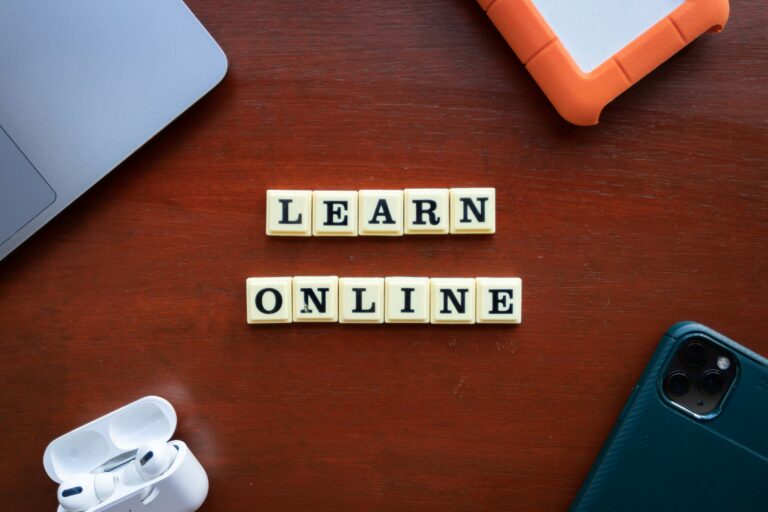Unleashing the power of music, harnessing it’s magical allure, and mastering an instrument is a dream for many. In the digital age, where learning has transgressed physical boundaries and time constraints, online learning platforms offer immense opportunities. This post is your ultimate guide to unlocking your musical potential, mastering a musical instrument of your choice, and that too, without spending a dime! 🎵🎶

This guide provides an in-depth insight into various free online platforms, dissecting their features, advantages, and how to optimally utilize them to master a musical instrument. Ranging from guitars to pianos, from basic levels to advanced, these platforms cater to a wide array of musical interests and expertise levels. The internet is filled with resources, but navigating through this vast sea of information can be overwhelming. Therefore, we’ve done the heavy lifting for you. 💻🎹🎸
It doesn’t matter whether music is a beloved hobby, a newfound interest, or a lifelong profession; this post is designed to cater to everyone who carries a song in their heart. By the end of this guide, you’ll have a comprehensive understanding of the best free online resources to help you on your musical journey. So, sit back, relax, and let the harmonious journey begin. 🎼🎷🎻.
Understanding the Basics of Learning an Instrument Online
In the realm of music learning, the onset of digital technology has become a game-changer. No longer are you restricted to conventional, physical classes. Now, you have the option to master an instrument online, and that too, for free. It’s a convenient and cost-effective way to unlock your musical potential. But before jumping into the process, it’s crucial to understand some basics.
Choosing the Right Instrument
Before you begin your musical journey, one of the most important—and personal—decisions you’ll make is selecting the instrument you want to learn. This choice will not only define the soundscape of your experience, but it will also shape your learning process, daily practice routine, and long-term engagement. The right instrument should resonate with your musical taste, lifestyle, learning goals, and even your physical comfort.
When choosing an instrument, consider the following factors:
- Musical Style: What genres do you love? If you enjoy classical music, the violin or piano may appeal to you. If you’re drawn to folk or pop, the guitar could be a great fit.
- Portability and Space: Do you have room for a drum set, or would a compact keyboard be more practical?
- Cost and Maintenance: Some instruments, like digital keyboards or acoustic guitars, are budget-friendly and low-maintenance, while others like violins or brass instruments may require regular upkeep and investment.
- Physical Compatibility: Choose an instrument that suits your hand size, posture, and physical comfort, especially if you plan on long practice sessions.
Here’s a closer look at a few popular choices:
- Guitar: A highly versatile instrument, ideal for playing solo or with others. It covers a wide range of styles—from acoustic ballads and flamenco to jazz, blues, and rock. It’s also relatively affordable and easy to carry.
- Violin: Perfect for expressive, emotive playing. The violin is used in classical ensembles, modern soundtracks, and even folk traditions. It demands precision and ear training, offering great rewards with persistence.
- Drums: Excellent for those who feel rhythm in their bones. Drumming boosts coordination, timing, and energy. While acoustic sets require space and soundproofing, digital drum kits are compact and volume-adjustable for apartment practice.
Ultimately, the best instrument for you is one that inspires you to practice and play every day.
Understanding the Online Learning Process
Online learning is a flexible, powerful way to master an instrument—but it requires a mindset shift compared to traditional in-person lessons. With self-paced learning, you are in charge of your progress, and success depends largely on discipline, focus, and consistency.
Most online music platforms offer:
- Video tutorials recorded by experienced musicians or teachers
- Step-by-step lesson plans structured by skill level (beginner to advanced)
- Interactive tools, such as tuners, metronomes, chord diagrams, and notation playback
- Progress tracking through apps or dashboards
- Community forums or student groups for motivation, Q&A, and shared learning
Since you won’t have a teacher correcting your form in real time, it’s vital to pay close attention to your technique, record your practice sessions, and seek feedback whenever possible. Engage with fellow learners in community groups—many platforms like JustinGuitar, Yousician, or Simply Piano offer vibrant discussion forums where you can ask questions, join challenges, and share milestones.
Staying Motivated Throughout Your Journey
Learning an instrument—especially online—requires emotional stamina and long-term motivation. Unlike formal classroom settings with external accountability, online learning depends on your ability to stay inspired and self-driven, even when progress feels slow.
Here are a few ways to keep your momentum going:
- Set Specific Goals: Break your journey into manageable goals like “learn a song in two weeks” or “master all major chords by next month.”
- Celebrate Milestones: Every improvement counts. Record your first complete song, your fastest scale, or your cleanest strumming and compare with earlier attempts.
- Play Songs You Love: Motivation spikes when you can connect with music you already enjoy. Don’t just practice drills—learn songs that made you want to play in the first place.
- Join Online Challenges or Groups: Many platforms host monthly song challenges or skill-building games to keep learners engaged.
- Remind Yourself Why You Started: Keep a note, playlist, or video that reminds you of your original motivation for learning music.
Remember: progress is not always linear. There will be plateaus, breakthroughs, and setbacks. But every session, even a short one, adds up over time. The key is consistency, curiosity, and a love for the process—not just the outcome.n interact with other learners, share your progress, and get feedback.
Selecting the Right Online Platform
There are a plethora of platforms that offer free lessons on various instruments. However, not all platforms are created equal. When selecting an online platform, you need to consider the quality of instruction, the structure of the course, and the available resources. Here are some reliable platforms:
- YouTube: A vast repository of free lessons on virtually any instrument.
- TakeLessons Live: Offers free, live group classes for a variety of instruments.
- Fender Play: Provides free guitar, bass, and ukulele lessons.
Understanding the Limitations
While online learning has numerous benefits, it’s also important to understand its limitations. Without a physical instructor, you might not get instant feedback on your techniques. Therefore, you should be proactive in seeking feedback from online communities. Also, complex techniques might be challenging to learn without hands-on instruction.
Tips for Effective Online Learning
Online learning opens up a world of possibilities for aspiring musicians, offering flexibility, convenience, and access to a wide range of quality resources. However, it also presents unique challenges—especially in the absence of a physical instructor or classroom environment. To succeed, learners must cultivate discipline, self-awareness, and a proactive mindset. Below are several strategies to help maximize your progress and stay motivated throughout your musical journey.
Setting Up a Practice Schedule
One of the most critical components of success in learning an instrument—online or otherwise—is consistency. Regular, focused practice not only strengthens your technique but also helps develop muscle memory, rhythm, and musical intuition over time.
Instead of practicing sporadically for extended hours, aim for short, daily practice sessions. Even 15 to 30 minutes a day can yield impressive results when practiced with intention. This consistent exposure keeps your skills sharp and reduces the chances of losing progress between sessions.
To create an effective practice schedule:
Start small and build your routine gradually. It’s better to have five productive minutes than thirty distracted ones.
Set specific time blocks in your calendar, just like any other important appointment.
Divide your sessions into focused segments (e.g., warm-up, scales, technique drills, song practice, and review).
Track your progress using a practice journal or app to stay accountable and measure improvement.
Utilizing Online Resources
Make full use of the resources provided by the platform. This includes video tutorials, interactive lessons, and community forums. Don’t hesitate to ask questions and seek feedback from fellow learners.
Implementing Your Learning
Learning to play a musical instrument involves much more than just studying theory, memorizing scales, or perfecting finger placement. While foundational knowledge and technique are essential, the true heart of music lies in active application and creative expression. It’s about turning what you’ve learned into something living and dynamic—making music that reflects your personality, emotion, and artistic voice.
Once you’ve built a basic understanding of your instrument and mastered a few techniques, it’s crucial to move beyond passive learning. Begin integrating your knowledge into real musical experiences by playing actual songs, improvising melodies, or even composing your own original pieces. This stage of musical development not only solidifies your skills but also builds confidence, cultivates creativity, and keeps your motivation high.
Whether you’re strumming a familiar tune on the guitar, experimenting with chord progressions on the piano, or trying your hand at creating a melody on a digital audio workstation, implementation is where theory transforms into artistry.
Playing Along with Music
One of the most enjoyable and effective methods for putting your skills into practice is to play along with recordings. Accompanying a backing track or a full band arrangement allows you to immerse yourself in the music while simulating a live performance environment. This type of practice improves several key areas:
- Timing and Rhythm: Playing in sync with a track trains your internal sense of timing, helping you stay in the groove and develop a consistent tempo.
- Ear Training: Following along with recordings sharpens your ability to recognize patterns, chord changes, and musical cues by ear.
- Musical Memory: Repeating phrases with music reinforces memory and helps you retain songs more easily.
- Confidence and Expression: As you become more comfortable playing along, you’ll naturally begin to add your own expression, dynamics, and flair to the performance.
Whether you’re using professional backing tracks, karaoke versions, or simply jamming along to your favorite artist, this practice method brings excitement and real-world application to your learning process. It bridges the gap between practice and performance and reminds you that music, at its core, is meant to be played, felt, and shared.
Recording and Evaluating Your Performance
One of the most powerful tools in your musical development toolkit is the ability to record and evaluate your own performance. While practicing in real time is essential, recording allows you to step back and observe your playing from a different, more objective perspective. This process helps uncover subtle mistakes, inconsistencies, or habits that might go unnoticed while you’re focused on playing.
By regularly recording yourself, you create a tangible record of your progress. Listening back allows you to identify:
- Timing issues or rushed notes
- Inconsistent dynamics or phrasing
- Tension or stiffness in technique
- Areas that have improved over time
These insights are incredibly valuable for setting focused goals and tailoring your future practice sessions. Over time, you’ll notice how much you’ve grown—boosting your confidence and reinforcing your dedication to improvement.
Beyond self-evaluation, sharing your recordings in online music communities or forums—such as those on Reddit, YouTube, SoundCloud, or Facebook groups—can provide constructive feedback and encouragement. These communities often consist of learners, enthusiasts, and experienced musicians who are eager to offer tips, celebrate progress, and help you refine your craft.
Conclusion
In conclusion, “Unlock Your Musical Potential: Master an Instrument Online for Free” offers an unparalleled opportunity to ignite your passion for music. With digital technology at our fingertips, the world of music has become a more accessible playground than ever. No longer are musical skills limited to those who can afford traditional lessons, thanks to the availability of free online resources.
As we delve into the wealth of online tools, tutorials, and courses, we become our own masters, sculpting our musical prowess at our own pace. This modern era of learning breaks the constraints of geography and financial capacity, paving the way for a more inclusive and widespread musical literacy.
However, remember that the journey to mastering an instrument requires dedication and patience. It’s not just about hitting the right notes; it’s about understanding the language of music, expressing your emotions, and connecting with others through this universal medium. So, go ahead and unlock your musical potential today. The virtual stage awaits you, ready to be graced by your newfound skills.
Remember, the beauty of music lies in the fact that it is a never-ending journey of discovery and growth. So, take the first step, immerse yourself in the world of music and witness your own evolution as a musician. Start now, for the world of music waits for none. Don’t be shy, let your rhythm fly! 🎵🎶



